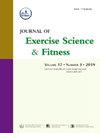运动对妊娠期糖尿病妇女血糖水平和妊娠结局的影响:荟萃分析和荟萃回归
IF 2.4
2区 医学
Q2 SPORT SCIENCES
引用次数: 0
摘要
背景:妊娠期糖尿病(GDM)会增加不良妊娠结局的风险。由于运动方案的差异,运动对GDM的影响仍然不一致。本综述旨在探讨运动对GDM妇女孕产妇和新生儿结局的影响,以及运动量与妊娠结局之间是否存在剂量反应关系。方法检索spubmed、Embase、Web of Science、EBSCO、ScienceDirect、Cochrane Library、中国知识基础设施、万方数据、VIP中国科技期刊全文数据库进行随机对照试验检索。采用Cochrane RevMan和R进行统计分析,采用Cochrane偏倚风险评估工具对研究进行评价。采用随机效应模型计算加权平均标准化平均差。采用I2评价异质性。结果共纳入24项研究,3477名受试者。荟萃分析的结果表明,运动显著降低空腹血糖(FBG) (SMD =−1.69,I2 = 96%, p & lt; 0.0001), 2 h餐后血糖(2-hPBG) (SMD =−2.10,I2 = 96%, p & lt; 0.0001),和糖化血红蛋白(MD =−0.95,I2 = 98%, p & lt; 0.0001)和降低妊娠高血压的风险(RR = 0.24, I2 = 0%, p & lt; 0.0001)和剖腹产(RR = 0.71, I2 = 53%, p = 0.0005),早产(RR = 0.51, I2 = 31%, p = 0.002),巨大胎儿(RR = 0.40,I2 = 19%, p & lt; 0.0001),和新生儿低血糖(RR = 0.49, I2 = 0%, p = 0.03)。亚组分析显示,适度有氧和阻力联合运动改善了FBG (SMD = - 2.39, I2 = 98%, p < 0.0001)、2-hPBG (SMD = - 2.96, I2 = 97%, p < 0.0001)、剖宫产(RR = 0.68, I2 = 40%, p = 0.02)、早产(RR = 0.46, I2 = 23%, p = 0.01)和巨大儿(RR = 0.27, I2 = 0%, p < 0.0001)的风险。此外,meta回归分析显示,运动量与2-hPBG之间存在显著的剂量-反应关系(β = - 0.004, I2 = 36.9%, p = 0.002)。结论:中等强度有氧和抗阻联合运动,每次至少30分钟,每周3天以上,持续至少6周,与GDM女性血糖控制的显著改善相关。它还可以降低剖腹产、早产和巨大儿的风险。这些发现强调了优化运动处方以提高孕产妇和新生儿健康的重要性。普洛斯彼罗临床试验注册号(CRD42021286338)。本文章由计算机程序翻译,如有差异,请以英文原文为准。
Effects of exercise on blood glucose levels and pregnancy outcomes in women with gestational diabetes mellitus: A meta-analysis and meta-regression
Background
Gestational diabetes mellitus (GDM) increases the risk of adverse pregnancy outcomes. Due to variations in exercise protocols, the effects of exercise on GDM remain inconsistent. This review aims to explore the effects of exercise on maternal and neonatal outcomes in women with GDM, and whether there is a dose-response relationship between exercise volume and pregnancy outcomes.
Methods
PubMed, Embase, Web of Science, EBSCO, ScienceDirect, Cochrane Library, China National Knowledge Infrastructure, WanFang Data, and VIP Chinese Science and Technology Periodicals Full-Text Databases were searched for randomized controlled trials. Cochrane RevMan and R were used for statistical analysis, and studies were evaluated using the Cochrane Risk of Bias Assessment Tool. Weighted-mean standardized mean differences were calculated using a random effects model. Heterogeneity was evaluated using I2.
Results
Twenty-four studies and 3,477 participants were included. Results from meta-analysis showed that exercise significantly lowered fasting blood glucose (FBG) (SMD = −1.69, I2 = 96 %, p < 0.0001), 2-h postprandial blood glucose (2-hPBG) (SMD = −2.10, I2 = 96 %, p < 0.0001), and glycated hemoglobin (MD = −0.95, I2 = 98 %, p < 0.0001) and reduced the risk of gestational hypertension (RR = 0.24, I2 = 0 %, p < 0.0001) and cesarean section (RR = 0.71, I2 = 53 %, p = 0.0005), preterm birth (RR = 0.51, I2 = 31 %, p = 0.002), macrosomia (RR = 0.40, I2 = 19 %, p < 0.0001), and neonatal hypoglycemia (RR = 0.49, I2 = 0 %, p = 0.03). Subgroup analyses indicated that moderate combined aerobic and resistance exercise improved FBG (SMD = −2.39, I2 = 98 %, p < 0.0001), 2-hPBG (SMD = −2.96, I2 = 97 %, p < 0.0001) and reduced the risks of cesarean section (RR = 0.68, I2 = 40 %, p = 0.02), preterm birth (RR = 0.46, I2 = 23 %, p = 0.01) and macrosomia (RR = 0.27, I2 = 0 %, p < 0.0001). In addition, the meta-regression analysis demonstrated a significant dose-response relationship between exercise volume and 2-hPBG (β = −0.004, I2 = 36.9 %, p = 0.002).
Conclusions
Moderate-intensity combined aerobic and resistance exercise, performed for at least 30 min per session on more than three days per week for at least six weeks, is associated with more pronounced improvements in glycemic control in women with GDM. It also reduces the risk of cesarean section, preterm birth, and macrosomia. These findings underscore the importance of optimizing exercise prescriptions to enhance both maternal and neonatal health.
Registration number for clinical trials
PROSPERO (CRD42021286338).
求助全文
通过发布文献求助,成功后即可免费获取论文全文。
去求助
来源期刊
CiteScore
5.10
自引率
3.60%
发文量
54
审稿时长
31 days
期刊介绍:
The Journal of Exercise Science and Fitness is the official peer-reviewed journal of The Society of Chinese Scholars on Exercise Physiology and Fitness (SCSEPF), the Physical Fitness Association of Hong Kong, China (HKPFA), and the Hong Kong Association of Sports Medicine and Sports Science (HKASMSS). It is published twice a year, in June and December, by Elsevier.
The Journal accepts original investigations, comprehensive reviews, case studies and short communications on current topics in exercise science, physical fitness and physical education.

 求助内容:
求助内容: 应助结果提醒方式:
应助结果提醒方式:


